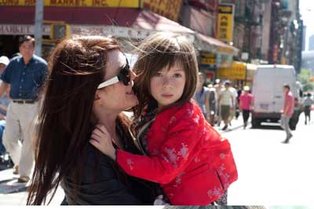Scott McGehee and David Siegel, the gay-straight (respectively) pair, have been filmmaking partners for more than two decades. Their latest collaboration, “What Maisie Knew,” is a superb adaptation of Henry James’ novel and opens May 24 at the Ritz East.
Set in present-day New York, this absorbing domestic drama depicts a fierce custody battle between Susanna (Julianne Moore) and Beale (Steve Coogan), but it is told shrewdly (and mainly) from their child Maisie’s (Onata Aprile) point of view.
In a recent phone interview, the filmmakers discussed how they came to this project. McGehee said: “Our entry point was the screenplay, not the novel. When we first encountered the story, neither of us had read the novel. We thought the story worked really well, and we had some ideas on what to do with it — make it contemporary, bring it downtown, focus on the characters’ relationships — and the screenplay was a model for what the film became.
“Then we went back to read the James novel as background.”
While there are characters in the novel compressed for the film, the directors were adamant about building their story around Maisie.
McGehee explained, “The foreground story is this little girl’s experience while all this [adult stuff] is happening in the background. We had to separate those two [story]lines and figure out the proper balance to keep focus on the foreground.” Siegel indicated that “What Maisie Knew” was built mostly in the editing room, where the story of the adults — which takes place mostly off-screen — was used to create ellipses in Maisie’s life. Time jumps are used to depict Beale’s courtship of his daughter’s nanny, Margo (Joanna Vanderham), and Susanna’s quickie marriage to affable bartender Lincoln (Alexander Skarsgård). These events further expose the divorced couple as bad lovers as well as bad parents; neither treats their new partner better than their former spouse, often forcing them into the role of default babysitter.
As a result, “What Maisie Knew” creates a strong sense of the abandonment and isolation the young girl feels over time as she is shuttled between parents and then jettisoned to her parents’ new lovers. This narrative arc puts Maisie — and her emotional responses — in bold relief. That Maisie feels more comfortable in either Margo or Lincoln’s presence than with her real mom or dad is something the filmmakers underscore at every opportunity. The directors were fortunate to find the young Aprile, who gives an incredible performance in the title role. “We had this extraordinary child … her face functioned so perfectly, conveying a sense of where she was emotionally in her life and story and the tenor of the movie at each moment,” praised Siegel.
He continued to gush about his leading little lady, “She was what we looked for — someone who could communicate a story just with her face — and get into her interior life. She doesn’t speak much, but we needed a kid still enough and pensive enough to act as that kind of mirror. She does function as a tabula rasa. Tilda [Swinton] did that in [our film] ‘The Deep End,’ but she was a 40-year-old woman with acting experience. This was a 6-year-old kid! It was strange to look at this little girl performing. Watching the subtlety of her eye flips, we’d be like, ‘This is fucking unbelievable!’”
Viewers will share the director’s enthusiasm for Aprile’s performance. Audiences may also appreciate Coogan’s turn as Beale, as the comedian was cast as Maisie’s father “to give the film some lightness,” Siegel said.
“He’s cast against type to do dramatic stuff,” added McGehee. “We knew Steve could act, and not just in comedic stuff. He proved us right. He relishes the idea of playing dicks.”
“We’re sure he’s a lovely father in real life,” Siegel added.
“What Maisie Knew” establishes its dramatic tension from the anxiety the directors create that something horrific is going to happen to Maisie at any given moment. Most of the film is shot at Maisie’s eye level, or framed by doorways or windows to magnify what is being said because the young girl is often eavesdropping.
Siegel acknowledged that this strategy was not planned during shooting but developed during editing.
“Some of it comes through sound design — dynamic modulations, big and small, and keeping others out of the frame as much as we did, and keeping the camera on the child. We also had sharp separations between the ellipses.”
While the filmmakers have crafted an impressive film about a disintegrating family, they admit when they parent a film, they do not fight with each other or on the set, or in front of their crew.
Siegel observed, “The lesson we learned early was never to fight in front of the children and never disagree in public.”
McGehee concurred, and rejected any notion of ending their creative partnership. “We met as friends and have been lucky to have kept this up for so long. I don’t think either one of us would be doing this on our own.”

